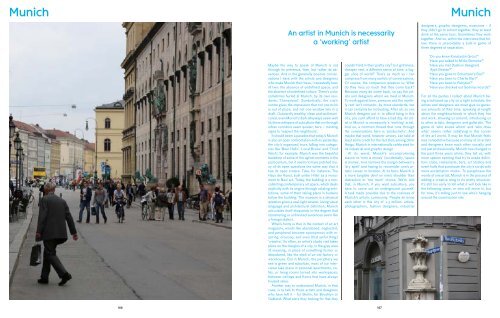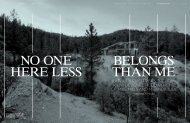munich - Katya Tylevich
munich - Katya Tylevich
munich - Katya Tylevich
You also want an ePaper? Increase the reach of your titles
YUMPU automatically turns print PDFs into web optimized ePapers that Google loves.
Munich<br />
An artist in Munich is necessarily<br />
a ‘working’ artist<br />
Maybe the way to speak of Munich is not<br />
through its presence, then, but rather its absences.<br />
And in the generally positive conversations<br />
I have with the artists and designers<br />
who make Munich their base, I repeatedly hear<br />
of two: the absence of undefined space, and<br />
the absence of undefined culture. There’s a slur<br />
sometimes hurled at Munich, by its own residents:<br />
‘Disneyland’. Symbolically, the city’s<br />
cen tre gives the impression that not one brick<br />
is out of place, and not one window lets in a<br />
draft. Outwardly wealthy, clean and well manicured,<br />
even Munich’s dark alleyways seem well<br />
lit; those whispers of subculture that run through<br />
urban corridors seem quieter, here – minding<br />
signs to ‘respect the neighbours’.<br />
It should seem a paradox that today’s Munich<br />
is also an open confrontation with its yesterday;<br />
the city’s organized tours falling into categories<br />
like ‘Beer Halls’, ‘Local Brews’ and ‘Third<br />
Reich’, for example. Munich was the beautiful<br />
backdrop of some of the ugliest moments in the<br />
past century, but it seems to have patched many<br />
of its open questions the same way that it<br />
has its open craters. Take, for instance, The<br />
Haus der Kunst, built under Hitler as a monument<br />
to Nazi art. Today, the building is a noncollecting<br />
contemporary art space, which deals<br />
explicitly with its origins through rotating exhibitions,<br />
some of them taking place in bunkers<br />
below the building. The museum is a physical<br />
question given a sealtight answer. Using visual<br />
language and architectural definition, Munich<br />
articulates itself eloquently to the degree that<br />
stammering or unfinished sentences seem like<br />
a foreign dialect.<br />
What’s funny is that in the context of an art<br />
magazine, words like abandoned, neglected,<br />
and peripheral become synonymous with inspiring,<br />
arousing, and even (that awful thing)<br />
‘creative’. So often, an artist’s studio visit takes<br />
place on the margins of a city, in the grey area<br />
of meaning, in place of something former or<br />
abandoned, like the shell of an old factory or<br />
warehouse. But in Munich, the periphery we<br />
see is green and suburban, most of our interviews<br />
take place in personal apartments, cafés,<br />
or living rooms turned into workspaces:<br />
between ceilings and floors that have always<br />
housed value.<br />
Another way to understand Munich, in that<br />
case, is to talk to those artists and designers<br />
who have left it – for Berlin, for Brooklyn or<br />
Oakland. What were they looking for that they<br />
couldn’t find in their pretty city? Is it grittiness,<br />
cheaper rent, a different sense of time, a bigger<br />
slice of world? That’s as much as I can<br />
compress from many earfuls of conversations.<br />
Of course, the companion question is: What<br />
do they miss so much that they come back?<br />
Because many do come back, so say the artists<br />
and designers whom we meet in Munich.<br />
To work against time, pressure and the monthly<br />
rent isn’t romantic, by most standards, but<br />
it can certainly be motivating. After all, as one<br />
Munich designer put it: to afford living in this<br />
city, you can’t afford to have a bad day. An artist<br />
in Munich is necessarily a ‘working’ artist.<br />
And so, a common thread that runs through<br />
the conversations here is ‘productivity’. And<br />
maybe that word, however unsexy, can take at<br />
least some credit for the fact that, among other<br />
things, Munich is internationally celebrated for<br />
its industrial and graphic design.<br />
At its worst, Munich’s uncompromising<br />
stance on ‘time is money’ (incidentally, ‘space<br />
is money’, too) narrows the margin between a<br />
‘dry spell’ and having to reconsider one’s artistic<br />
career or location. At its best, Munich is<br />
a more tangible devil on one’s shoulder than<br />
distraction or ‘too much’ choice. We’re told<br />
that, in Munich, if you want subculture, you<br />
have to carve out an underground yourself.<br />
A task made possible due to the coziness of<br />
Munich’s artistic community. People do know<br />
each other in this city of 1.3 million: artists,<br />
photographers, fashion designers, industrial<br />
166 167<br />
Munich<br />
designers, graphic designers, musicians – if<br />
they didn’t go to school together, they at least<br />
drink at the same bars. Sometimes they work<br />
together. And so, within the interviews that follow,<br />
there is unavoidably a builtin game of<br />
three degrees of separation.<br />
‘Do you know Konstantin Grcic?’<br />
‘Have you talked to Mirko Borsche?’<br />
‘Have you met (fashion designer)<br />
Ayzit Bostan?’<br />
‘Have you gone to Schumann’s Bar?’<br />
‘Have you been to Charlie Bar?’<br />
‘Have you been to Rubybar?’<br />
‘Have you checked out Gomma records?’<br />
For all the quotes I collect about Munich being<br />
a buttonedup city on a tight schedule, the<br />
artists and designers we meet give us generous<br />
amounts of their time, speaking at length<br />
about the neighbourhoods in which they live<br />
and work, showing us around, introducing us<br />
to other artists, designers and gallerists. The<br />
game of ‘who knows whom’ and ‘who does<br />
what’ seems rather satisfying in this corner<br />
of the art world. It may be that Munich feels<br />
less competitive because so many of its artists<br />
and designers know each other socially and<br />
not just professionally. Munich has changed in<br />
the past three years alone, they tell us, with<br />
more spaces opening that try to evade definition:<br />
clubs, restaurants, bars, art studios and<br />
event halls that punctuate the city’s script with<br />
more exclamation marks. To paraphrase the<br />
words of one artist, Munich is in the process of<br />
adding a creative wing to its pretty structure.<br />
It’s still too early to tell what it will look like in<br />
the following years, or who will move in, but<br />
for now, it’s telling just to see who’s hanging<br />
around the construction site.



